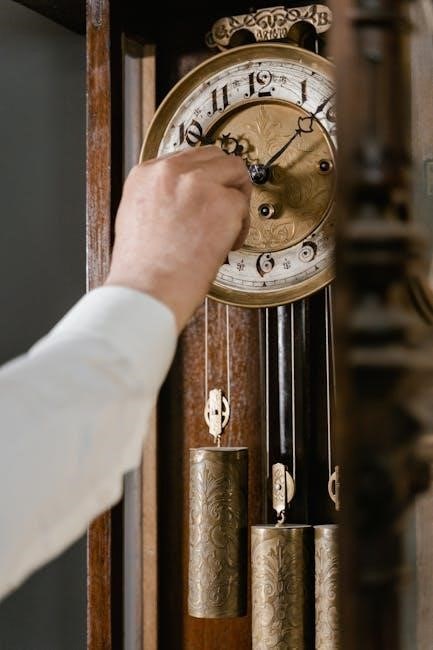What is a Manual Winding Watch?
A manual winding watch, also known as a hand-wound watch, requires the wearer to wind its mainspring daily by turning the crown to power the timepiece․
What is a Manual Winding Watch?
A manual winding watch, also known as a hand-wound watch, is a timepiece that requires the wearer to wind its mainspring by turning the crown to generate power․ Unlike automatic watches, which rely on motion to wind, manual winding watches need daily attention to function․ The process involves turning the crown clockwise to tighten the mainspring, which stores energy to power the watch’s movement․ This traditional mechanism is often appreciated for its craftsmanship and simplicity, as it lacks the rotor found in automatic watches․ Regular winding ensures the watch runs accurately, making it a beloved choice for collectors and horology enthusiasts․

History and Evolution
Manual winding watches trace their origins to early pocket watches in the 16th century, evolving over centuries as the primary timekeeping mechanism before automatic watches emerged․
Key Milestones in the Development of Manual Winding Watches
Manual winding watches have a rich history, with milestones including the invention of the mainspring in the 16th century, the development of precise escapement mechanisms in the 17th century, and the introduction of the crown for winding in the 19th century․ These innovations refined accuracy and usability, solidifying manual winding as a cornerstone of horology․ By the 20th century, automatic watches gained popularity, but manual winding remained a cherished tradition, appreciated for its craftsmanship and tactile experience․
Manual winding watches operate by turning the crown, which winds the mainspring․ This daily ritual stores energy, powering the watch’s mechanical movement until the next winding․
How Manual Winding Watches Work
The Mechanics Behind Manual Winding
Manual winding watches rely on a mainspring that stores mechanical energy․ Turning the crown winds the spring via a gear train, transferring energy to the movement․ The process involves winding the crown clockwise, typically 30-40 times, to activate the movement․ The mainspring unwinds gradually, powering the watch’s gears and escapement․ Over-winding should be avoided to prevent damage․ This mechanism requires daily attention, ensuring the watch remains accurate and functional․ The winding process engages the crown wheel and click, ensuring unidirectional winding to protect internal components․

Advantages and Disadvantages
Manual winding watches offer affordability, slim designs, and a satisfying tactile experience but require daily winding, risking over-winding damage and needing careful handling․
Pros and Cons of Owning a Manual Winding Watch
Manual winding watches offer a unique charm, with advantages like affordability, slim designs, and a tactile winding experience․ They often feature intricate mechanical craftsmanship and are prized by collectors․ However, they require daily winding, which can be inconvenient, and may stop if forgotten․ Over-winding risks damaging the mechanism, and they generally lack the convenience of automatic or quartz watches․ Despite these drawbacks, many enthusiasts appreciate the connection to horological tradition and the satisfaction of manually powering their timepiece․
Regularly wind your manual watch to maintain accuracy, typically 30-40 turns daily․ Avoid over-winding, which can damage the mechanism․ Wind clockwise and set the time carefully․
Maintenance and Care
Best Practices for Winding and Maintaining Your Watch
Wind your manual watch daily, typically 30-40 turns, to ensure optimal performance․ Use a consistent winding technique, turning the crown clockwise until resistance is felt․
Avoid over-winding, as this can damage the mainspring․ Set the time accurately after winding, ensuring the second hand starts moving․
For storage, keep the watch away from magnets and extreme temperatures․ Use a watch winder if storing for extended periods․
Regular servicing by a professional every 3-5 years is essential to maintain precision and longevity․
Handle the crown gently to prevent strain and ensure the watch is clean to avoid dust buildup in the mechanism․
Manual winding watches require daily winding, automatics use wearer’s movement, and quartz watches rely on batteries․ Each offers unique benefits, from personal connection to convenience and accuracy․

Manual vs․ Automatic vs․ Quartz Watches
A Comparison of Watch Movements
Manual winding watches require daily winding via the crown, offering a personal connection to timekeeping․ Automatic watches harness kinetic energy from the wearer’s movements, eliminating the need for manual winding․ Quartz watches, powered by batteries, provide high accuracy and low maintenance․ Manual watches are prized for their craftsmanship and mechanical beauty, while automatics combine convenience with heritage․ Quartz watches excel in precision and affordability․ Each movement type caters to different preferences, whether for tradition, practicality, or simplicity․
A manual winding watch’s power reserve indicates how long it runs without winding․ Typically ranging from 38 to 80 hours, it depends on the mainspring’s energy storage․

Power Reserve in Manual Winding Watches
Understanding the Power Reserve and Its Implications
The power reserve of a manual winding watch indicates how long it can operate without being wound․ Typically, this ranges from 38 to 80 hours, depending on the movement’s efficiency and mainspring capacity․ A higher power reserve means less frequent winding, offering greater convenience for the wearer․ However, as the mainspring unwinds, the watch’s accuracy may slightly vary due to isochronism error․ The power reserve is a critical factor for collectors and enthusiasts, as it reflects the engineering and craftsmanship of the timepiece․ Regular winding ensures optimal performance and longevity of the watch․

Manual Winding Watches for Collectors
Manual winding watches are highly sought after by collectors for their mechanical beauty and historical significance, making them cherished pieces in any horology collection․
Why Collectors Love Hand-Wound Timepieces
Collectors adore manual winding watches for their craftsmanship, historical significance, and tactile experience․ The ritual of winding fosters a connection to horological heritage, while the visible mechanics inspire appreciation․ The power reserve, often longer in hand-wound movements, adds practical appeal․ Exclusivity and rarity also drive demand, as these timepieces are less common than automatic or quartz watches․ For enthusiasts, the combination of artistry, functionality, and nostalgia makes manual winding watches true treasures in any collection․
Manual winding watches are timeless pieces that combine craftsmanship with daily interaction, cherished for their mechanical beauty and historical significance, offering a unique connection to watchmaking heritage․
Final Thoughts on Manual Winding Watches
Manual winding watches offer a unique blend of tradition, craftsmanship, and personal interaction․ They require daily attention, fostering a special connection between the wearer and the timepiece․ Unlike automatic or quartz watches, their mechanical beauty lies in simplicity, with no rotor to automate winding․ This makes them lighter and often more affordable․ While they demand regular care, the ritual of winding is meditative, providing a sense of control and appreciation for horological artistry․ For collectors and enthusiasts, these watches embody history, elegance, and the joy of mechanical precision, making them timeless companions for those who cherish tradition and craftsmanship․